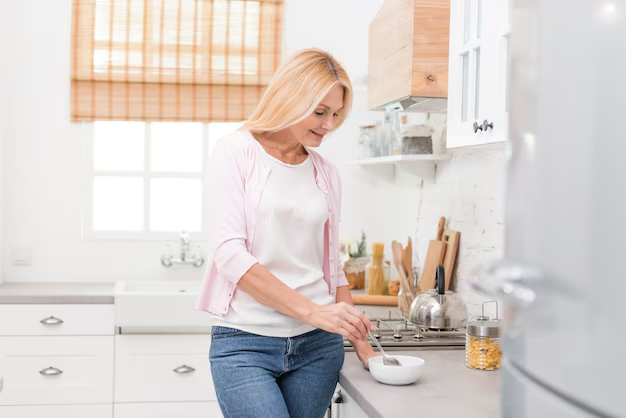Should You Really Put Warm Food in the Refrigerator? What You Need to Know
In the fast-paced rhythm of modern life, understanding how to properly store leftovers is a crucial skill. One common question that arises in the kitchen is whether it's safe to place warm food directly into the refrigerator. This query goes beyond mere curiosity, touching on food safety, nutritional value, and energy efficiency. Let's dive deeper into these matters to offer a comprehensive guide on how to handle your culinary creations post-cooking.
The Basics of Refrigeration
How Refrigerators Work
Refrigerators are designed to slow the growth of bacteria by maintaining a temperature below 40°F (4°C). This temperature threshold is critical because bacteria thrive in warmer environments. Lowering the temperature of food quickly is key to preventing bacteria from multiplying.
Understanding the "Danger Zone"
The term "Danger Zone" refers to the temperature range between 40°F and 140°F, where bacteria grow most rapidly. Food safety guidelines often emphasize minimizing the amount of time food stays in this zone to reduce the risk of foodborne illnesses.
Is It Safe to Put Warm Food in the Refrigerator?
Common Misconceptions
A widespread belief is that placing warm food in the refrigerator can cause the appliance to work overtime, potentially spoiling other food or even damaging the fridge. While it may cause a slight increase in refrigerator energy consumption, the impact on both the appliance and the surrounding food is generally negligible if managed correctly.
Balancing Act: Temperature and Timing
Proper handling involves balancing the need to cool food rapidly against the risk of raising the internal temperature of the fridge. Brief Tip: Avoid placing piping hot dishes directly onto shelves. Allow food to cool slightly before storing; aiming for a lukewarm temperature should suffice.
Best Practices for Cooling and Storing Food
Dividing Large Quantities
For large batches of food, divide the portions into smaller containers to enable quicker cooling. Shallow containers allow for more surface area exposure, speeding up the cooling process.
Covering and Ventilation
Cover food loosely to allow steam to escape. Once cool, cover them tightly to protect against moisture and odor transfer. Note: Leaving food uncovered for too long can cause drying out or contamination.
Energy Efficiency Considerations
Refrigerator Performance
While putting warm food inside can cause the fridge to use marginally more energy to maintain its internal temperature, modern refrigerators are designed to handle such fluctuations. Good habits, like leaving space around containers for air circulation, enhance efficiency and cooling speed.
Environmental Factors
Keep the refrigerator door closed as much as possible to prevent excess warm air from entering. Maintaining an organized fridge layout also helps minimize the amount of time the door stays open.
Debunking Myths: Will Warm Food Spoil the Refrigerator?
Appliance Durability
Refrigerators can withstand occasional introductions of warm food without sustaining damage. Frequent occurrences, however, can affect overall efficiency over time, leading to slightly elevated electricity bills.
Food Safety Reinforced
Instead of being concerned about the appliance, it’s vital to focus on the food's safety and texture. Foods that aren't cooled quickly enough can harbor bacteria, which might not be visible or change the food's smell, making them deceptive and dangerous.
Exploring Related Subtopics
The Role of Food Storage Containers
Choosing the right container for storage is critical. Opt for containers that are not only fridge-safe but also serve dual purposes—such as being microwave-safe for easy reheating. Glass containers are often preferred for their non-reactive properties and durability.
Shelf Organization
Proper organization of the refrigerator shelves involves placing newer food towards the back and older items in front to facilitate the first-in, first-out rule. Designate specific areas for leftovers to ensure they're used promptly.
Practical Tips for Safe and Efficient Food Storage
Here's a simple checklist for safely storing warm food that balances safety and efficiency:
- 🍲 Divide and Conquer: Split large batches into smaller portions for quicker cooling.
- 🌡️ Monitor Temperatures: Allow food to reach a safe temperature level, slightly above room temperature, before refrigeration.
- 🌀 Foster Air Circulation: Avoid overcrowding the fridge to maintain efficient cooling.
- 🕒 Time Management: Open the refrigerator door sparingly and briefly to preserve the internal temperature.
- 🛡️ Seal Containers: Ensure containers are sealed tightly post-cooling to preserve taste and prevent contamination.
A Thoughtful Approach to Food Safety and Storage
While the debate about placing warm food in the refrigerator continues in some kitchens, a balanced, informed approach to cooling and storing food can maximize safety and efficiency. Understanding these concepts can transform cooking habits, minimize waste, and ensure food remains safe to eat. As we become more conscious about food safety and efficiency, the way we handle leftovers can contribute significantly to a healthier lifestyle.
Embrace a thoughtful approach to how you cool and store food, and enjoy peace of mind knowing that your methods are equally considerate of your health and the environment.
